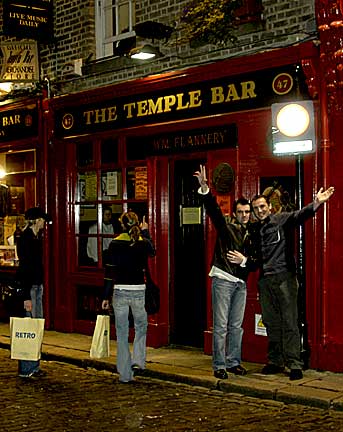
Welcome to Dublin, Ireland described by many as the "richest happiest city in Europe." After a period of rapid economic growth since joining the European Union, the city is now covered by a canopy of cranes--construction crews are hard at work extending the city upward.
Don't expect to find a traditional Irish population but instead a mix of cultures making it difficult to determine who is a tourist and who is a resident. An influx of people from Oriental and Slavic countries settled on the island to fill jobs no longer popular with the now upwardly mobile local citizenry. A giveaway for who's who is in listening to conversations; locals do not pronounce the letter "h."
Dublin's streets currently are packed with tourists. Many may be taking advantage of the cheap airfares from other cities in Europe. Some are young, backpacking their way, with a rail pass in hand and a list of hostels to bed down at. Unfortunately, the dollar is rapidly losing ground to the euro, currently less than 25% in value. For that reason fewer Americans are !seen on holiday here.
The most popular tourist spot is the Guinness factory where the price of admission gets everyone a free pint of the dark liquid gold that made the Guinness family millions. Now a public company, the brewery churns out 4,000,000 pints of beer daily with 2,000,000 pints for local consumption.
One of the guides on a Dublin Tours bus reminds everyone to visit the museums of the city housing fine art and the country's history from the Stone Age to the present. Reportedly one of the finest collections of prehistoric gold artifacts in Europe is found in the National Museum of Archeology and History. What's more, all public museums are free of charge.
Other places not to be missed are Trinity College, the bridges over the River Liffey, Christ Church and St. Patrick's Cathedral, St. Stephen's Green (the largest park in Europe) and the shopping area of Grafton Street. Although the Temple Bar takes its name from the area in which it is located, it is not necessarily the local's choice for lifting a few. The Oliver St. John Gogarty Bar & Restaurant brags about their Irish stew, certainly something to savor, and offers Irish entertainment nightly but it can be disappointing when compared to the folk fiddling done in the Ozarks.
The queue of people found standing outside public buildings, including bars, probably are taking a smoking break. The Irish government recently without consulting the people decided that all public establishments would be smoke-free. (Oh, were that the case in Joplin: instead of fluoridating the water supply, creating a ban to rid of third party smoke!)
The buildings in the city will delight many historians of architecture. Although there is a mix of the new with the old, the city fathers finally have realized the significance of preserving the old Georgian structures and of keeping a sense of history in any new construction. In addition to the colourful doorways and decorative fascia in the residential areas, the buildings housing shops have an old world quality about them.
A monument of sorts called The Spire was erected in 2003 in the downtown area as a replacement for a landmark blown up by the Irish Republican Army in 1966. It is a stainless steel needle-like structure measuring 120 metres high making it the world's tallest. Lit by small LEDs, at night it glows a ghostly gray-blue.
Statues, the bases of which are used for resting places, are focal points of the city. The most photographed are the statues of Molly Malone wheeling her cart "through streets broad and narrow" and of James Joyce, the writer of the novel "Ulysses." The haunts of Joyce's main characters, Stephen Dedalus and Leopold Bloom, are proudly pointed out by everyone.
The works of other famous writers including Yeats, Wilde, Swift Behan, Shaw, Stoker and Beckett are also celebrated. The Trinity College Library entitled to a free copy of every book published in the UK and Ireland houses works of these writers, many of whom were Trinity College graduates.
A Dublin Literary Pub Crawl guided by Irish actors who perform humorous extracts from Dublin's best known actors takes place nightly during the weekends in the winter season. The actors are said to remind everyone that Dublin's literature always has been constructed out of great jokes.
A quick and inexpensive ride on the DART, Dublin's rail system will take a passenger from downtown Dublin to Dun Laoghaire, Sandy Cove or Dalkey on the Irish Sea. Medieval castles dot the winding streets of Dalkey, a rich area in County Dublin where quaintness abounds and a large German-Irish population resides.
'Onward to Paris and Bruges shortly...in the meantime enjoy some of the sights shot in County Dublin.
|
|
|
|
|
|
|
|
|
|
|
|
|
|
|
|
|
|
|
|





















Comments